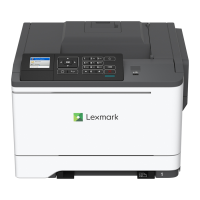Interfaces
8-9
• To prevent line noise, the cables should be shielded and connected to the
chassis of both the computer and the printer. The parallel cable length should
not exceed 3.04 m (10 ft), unless a Lexmark 6.1 m (20 ft) parallel cable is
used.
Table 8-1: Parallel Connector Pin Assignments
Pin
Signal Direction Description
IEEE 1284-B Connector
IEEE 1284-C Connector
115STROBE*
Inverted logic:
signal is active
when low
In The computer generates this signal to allow the printer to read in
data. The signal level is normally high: data is sampled at the
falling edge of this pulse.
2–96–13 DATA0 through
DATA7
In/Out These signals represent data bits 0 to 7, respectively. Each signal
is at a high level when data is logical 1, and low when data is
logical 0. Pin 2 is the least significant bit.
Note: Data is driven out only when the printer is in IEEE 1284
Byte or ECP modes.
10 3 ACKNLG*
Inverted logic:
signal is active
when low
Out This negative pulse indicates the printer can again accept data.
11 1 BUSY Out A high signal indicates the printer cannot receive data. The signal
is high:
• During initialization
• During data sampling
• When the buffer is full
• In the not ready state
• During a printer error
A low signal indicates the printer is not busy and the computer can
again send data.
12 5 PE Out Paper Exception signal indicates no paper is loaded, a paper jam
exists, or a paper feed error occurred.
13 2 SLCT Out Select signal indicates the printer is selected and is online. This
signal is normally active. It becomes inactive when the printer is
offline.
N/A means non-applicable.

